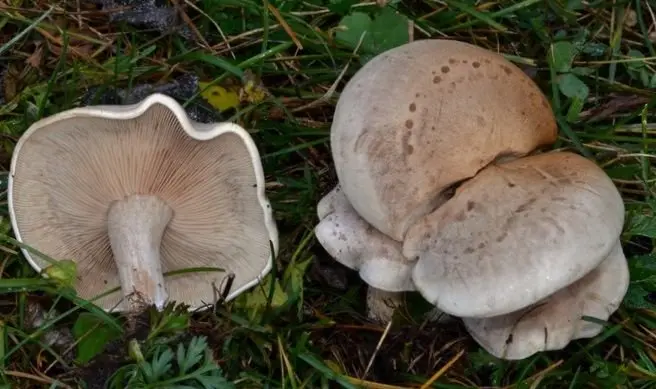One-eyed lepista (Lepista luscina)
- Division: Basidiomycota (Basidiomycetes)
- Subdivision: Agaricomycotina (Agaricomycetes)
- Class: Agaricomycetes (Agaricomycetes)
- Subclass: Agaricomycetidae (Agaricomycetes)
- Order: Agaricales (Agaric or Lamellar)
- Family: Tricholomataceae (Tricholomovye or Ryadovkovye)
- Genus: Lepista (Lepista)
- Type: Lepista luscina (One-eyed Lepista)
- Ryadovka one-eyed
- Austroclitocybe luscina
- Melanoleuca luscina
- Omphalia lucina
- Clitocybe luscina
- Lepista panaeolus var. irinoides
- Lepista panaeolus *
- Clitocybe nimbata *
- Paxillus alpista *
- Tricholoma panaeolus *
- Gyrophila panaeolus *
- Rhodopaxillus panaeolus *
- Rhodopaxillus alpista *
- Tricholoma calceolus *

head with a diameter of 4-15 (some reach even 25) cm, in youth hemispherical or cone-shaped, then flat-convex (cushion-shaped), and up to prostrate concave. The skin is smooth. The edges of the cap are even, bent in youth, then lowered. The color of the cap is gray-brownish, gray, there may be slight, conditional cream or lilac shades of the overall gray or gray-brownish color. In the center, or in a circle, or in concentric circles, spots of a watery nature may be located, for which she received the epithet “one-eyed”. But spots may not be, see footnote “*”. Towards the edge of the cap, the cuticle is usually lighter, in some cases it may appear as if frostbitten or frosty.
Pulp grayish, dense, fleshy, in old mushrooms it becomes loose, and in wet weather, also watery. The smell is powdery, not pronounced, may have spicy or fruity notes. The taste is also not very pronounced, mealy, can be sweetish.
Records frequent, rounded to the stem, notched, in young mushrooms almost free, deeply adherent, in mushrooms with prostrate and concave caps, they look like accreted, and, possibly, descending, due to the fact that the place where the stem passes into the cap becomes not pronounced , smooth, conical. The color of the plates is grayish, brownish, usually in tone with the cuticle, or lighter.
spore powder beige, pinkish. Spores are elongated (elliptical), finely warty, 5-7 x 3-4.5 µm, colorless.
Leg 2.5-7 cm high, 0.7-2 cm in diameter (up to 2.5 cm), cylindrical, can be widened from below, clavate, can be, conversely, narrowed towards the bottom, can be curved. The pulp of the leg is dense, in aged mushrooms it becomes loose. The location is central. Leg color of mushroom plates.
The one-eyed lepista lives from August to November (in the middle lane), and from spring (in the southern regions), in meadows, pastures, on the banks of reservoirs, on roadsides, railway embankments and other similar places. It can be found on the edges of forests of any kind, in clearings. Grows in rings, rows. Often there are mushrooms growing so densely that they seem to have grown together due to growth from a small area of uXNUMXbuXNUMXbground, strongly sprouted with mycelium.
- Lilac-legged rowing (Lepista saeva) Differs, in fact, in a lilac leg, and the absence of spots on the hat. Among the purple-footed specimens come across with an unexpressed purple leg, which are completely indistinguishable from the one-eyed non-spotted ones, and can be distinguished only by the fact that they grew in the same row with the colorful ones. In terms of taste, smell, and consumer qualities, these species are absolutely identical. In our country, as a rule, one-eyed leptists are considered precisely lilac-legged rows with not pronounced lilac legs, since one-eyed, for unclear reasons, has been studied quite little in our country.
- Steppe oyster mushroom (Pleurotus eryngii) It is distinguished by strongly descending plates at any age, a curved shape of the fruiting body, an eccentric stem, and often a contrast in the color of the plates relative to the cap.
- Crowded lyophyllum (Lyophyllum decastes) and armored lyophyllum (Lyophyllum loricatum) – differ in the structure of the pulp, it is much thinner, fibrous, cartilaginous in armored ones. They differ in significantly smaller cap sizes, uneven caps. They differ in the contrast of the color of the cap cuticle compared to the color of the stem and plates. They grow differently, not in rows and circles, but in heaps that are located at a distance from each other.
- The grayish-lilac rowing (Lepista glaucocana) differs in its place of growth, it grows in forests, rarely goes far to the edges, and one-eyed, on the contrary, practically does not occur in the forest. And, in fact, it differs in the color of the plates and legs.
- The smoky talker (Clitocybe nebularis) differs in its place of growth, it grows in forests, rarely goes far to the edges, and one-eyed, on the contrary, is practically never found in the forest. The plates of the govorushka are either adherent (at a young age) or noticeably descending. There is a noticeable contrast of color between the gray cuticle and the bright white plates, and the one-eyed lepista does not have such white plates.
- Lepista Ricken (Lepista rickenii) at first glance, it seems, is indistinguishable. The cap and stem have on average the same proportions, the same color scheme, maybe the same spotting, and the same frost-like coating. However, there is still a difference. Lepista Riken has plates from adherent to slightly descending, and it grows not only in meadows and pastures, but also on the edges of forests, in clearings, especially with the presence of pine, oak, and other trees are not a hindrance to it. It is easy to confuse these two types.
Lepista one-eyed – Conditionally edible mushroom. Delicious. It is completely similar to the lilac-legged rowing.









